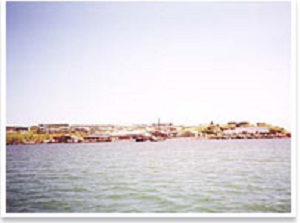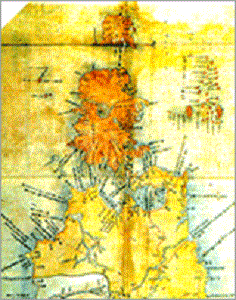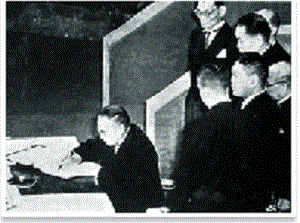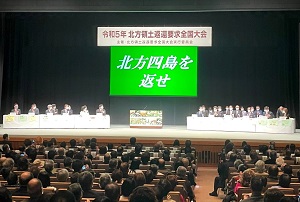Northern Territories Affairs AdministrationOverview of the Issue of the Northern Territories
- Japanese
- English
Northern Territories Affairs Administration

1.The Stolen Islands
What is the Northern Territories issue in the first place?

Located to the northeast of Hokkaido, the Habomai, Shikotan, Kunashiri and Etorofu Islands, collectively called the Northern Territories, had been developed and continuously inhabited by Japanese citizens. However, in August 1945, immediately after the end of World War II, the Northern Territories were illegally occupied by the armed forces of the Soviet Union (current Russia), becoming islands where Japanese citizens could not live even though they belonged to Japan. The Northern Territories issue is a critical task involving national sovereignty: achieving as early as possible the return of the Northern Territories, which remain illegally occupied by Russia even after more than 75 years have passed since the end of World War II.
The war ended and the illegal occupation began.
At the last stage of World War II, specifically on August 9, 1945, the Soviet Union entered the war against Japan in violation of the Japan-Soviet Neutrality Pact (an agreement between Japan and the Soviet Union not to invade each other), which was still in force between both countries. It was August 18, three days after Japan’s August 15 surrender to the Allies by accepting the Potsdam Declaration, when the Soviet Union landed its troops on the Kurile Islands.
Then Soviet forces continued their offensive southward down the islands and seized the Etorofu, Kunashiri, Shikotan and Habomai Islands one after another during the period from August 28 to September 5.
At the end of the war, there were approximately 17,000 Japanese people living on Etorofu and the other islands south of it. Following the illegal occupation by Soviet forces, half of the residents, out of insecurity and fear, escaped from the islands on their own in small boats. However, the remaining residents failed to do so and, after living hard lives in Sakhalin, etc., were forcibly deported to the mainland of Japan over the 1947-1949 period.
Since then, the Four Northern Islands have been under illegal occupation by Russia for over 75 years after the end of the war.
2.The Northern Territories―an Integral Part of Japan’s Sovereign Territory
The history of the development of the Northern Territories

In 1635, the Matsumae Domain, a feudal domain governing Hokkaido, conducted a field survey of the Ezo region, which comprised the entire island of Hokkaido, the Kurile Islands and Sakhalin. On the Shouhou Gokoku Ezu, a map of Japan prepared by the Edo government in 1644, island names such as "Kunashiri", "Etohoro" and "Urufu" can be clearly identified. In 1766, Russians came to Uruppu Island for the first time. They stayed there for a while, but encountered resistance from the residents and returned home the following year. Thereafter, Russians repeatedly advanced on the islands, continually causing conflicts with the residents. To prevent a Russian invasion, the Edo government was determined to put the Ezo region, including the Kurile Islands and Sakhalin, under its direct control. Over the years 1799 and 1800, the government partially transferred its administration from the mainland to Etorofu Island and introduced the gou-son system (a governing system based on an administrative unit called gou, which was formed by multiple sons, or villages). The government opened fisheries and permanently stationed government officials there, while preparing seaways and harbors to undertake the full-scale development of the Shikotan, Kunashiri and Etorofu Islands. Thus, the Northern Territories are Japanese land that had been developed by Japanese citizens without in fact being settled on by foreigners or put under foreign control.
How are the Northern Territories viewed historically and internationally?

Japan gave up its territorial rights to the Kurile Islands in the San Francisco Peace Treaty (a commitment executed to end the war between Japan and the Allies). However, the Northern Territories are not included in the Kurile Islands as provided for in this treaty.
Although Russia justifies its territorial claim to the Northern Territories using the Yalta Agreement, in which the US prompted the Soviet Union to enter the war against Japan on condition that the US would transfer the Kurile Islands to the Soviet Union, Japan is not bound by this agreement since it was merely a trilateral agreement among the US, UK and the Soviet Union. The US government, one of the parties to this agreement, has also officially stated that the agreement has no legal effect of enabling a territorial transfer (i.e., assigning the Northern Territories to Russia).
3.Returning the Four Islands to Japan
From a “campaign” to the designation of “Northern Territories Day”

Calls for the return of the Northern Territories by their ex-residents as well as the residents of Nemuro have extended throughout Hokkaido and into every part of Japan since just after the end of the war. The government was sensitive enough to pay heed to these calls. To provide nationwide back up for this campaign, the government in 1981 designated the 7th of February every year as “Northern Territories Day.” In fact, the 7th of February is the day when the Treaty of Commerce, Navigation and Delimitation between Japan and Russia was signed in Shimoda, a seaport on the Izu peninsula, in 1855, more than 150 years ago, by which the boundaries between Japan and Russia were established in a peaceful manner. Calling on Russia, which has violated these boundaries, to return the Four Northern Islands can be said to be a legitimate right of Japan.
To recover the Northern Territories
The Japanese government has taken up the Northern Territories issue as an important theme in government publicity, conducting a variety of public relations activities through TV, the radio, newspapers, magazines, etc. Consequently, the National Rally to Demand the Return of the Northern Territories held on February 7 is increasingly well attended every year. With the participation of the prime minister and the representatives of political parties, the government, the ex-residents of the islands and others involved in the return campaign join together to issue “strong messages” that consolidate the wishes of the Japanese public.
Returning the Four Islands to Japan

The continuation of persistent talks with Russia is necessary in order to resolve the Northern Territories issue. This can be sustained by your strong support and conveying the voices of the Japanese public to Russia. Habomai, Shikotan, Kunashiri and Etorofu Islands… For these islands located northeast of Hokkaido to be introduced to the world as the “Four Northernmost Islands of Japan” as early as possible, let’s call out together. “Return the Four Islands to Japan!”
